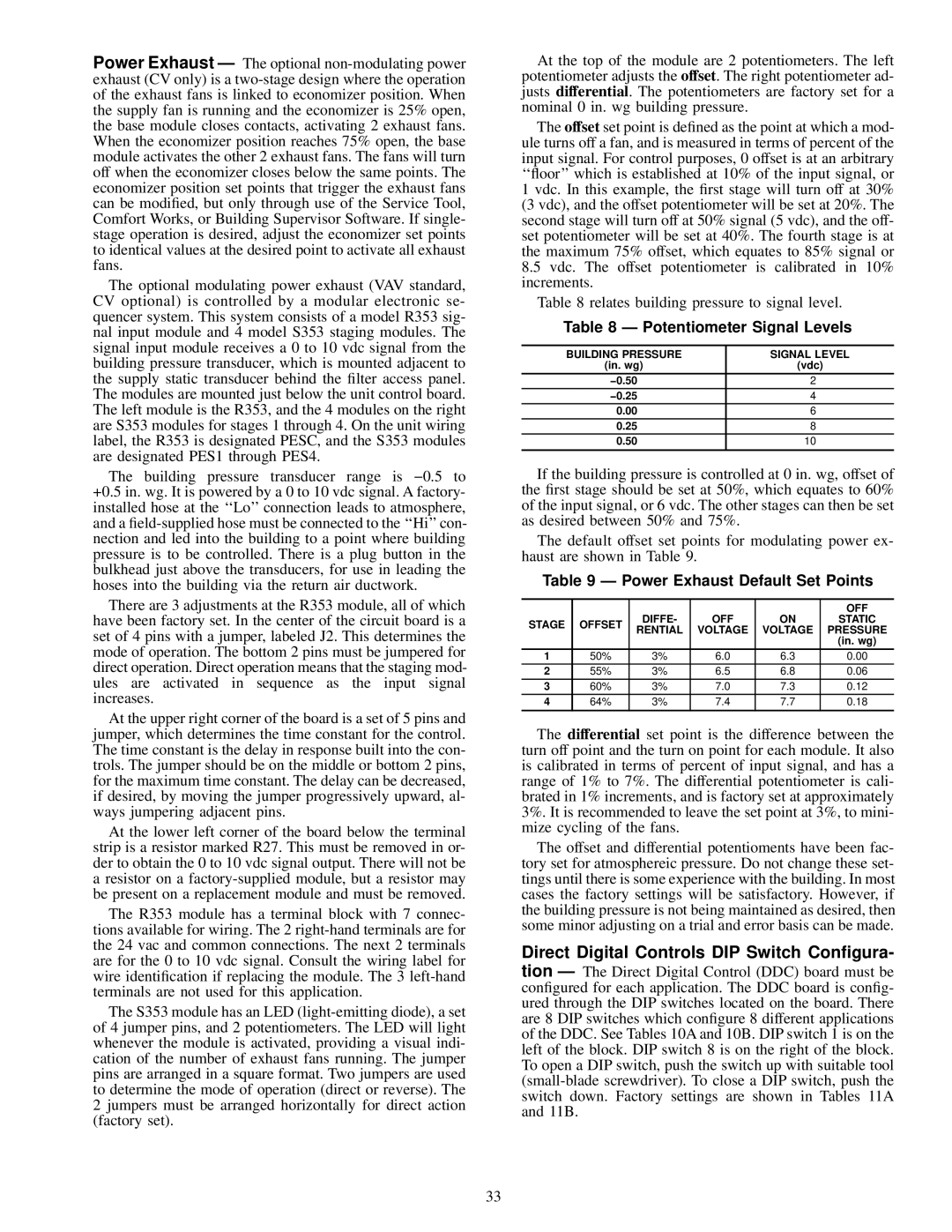Power Exhaust Ð The optional
The optional modulating power exhaust (VAV standard, CV optional) is controlled by a modular electronic se- quencer system. This system consists of a model R353 sig- nal input module and 4 model S353 staging modules. The signal input module receives a 0 to 10 vdc signal from the building pressure transducer, which is mounted adjacent to the supply static transducer behind the ®lter access panel. The modules are mounted just below the unit control board. The left module is the R353, and the 4 modules on the right are S353 modules for stages 1 through 4. On the unit wiring label, the R353 is designated PESC, and the S353 modules are designated PES1 through PES4.
The building pressure transducer range is −0.5 to +0.5 in. wg. It is powered by a 0 to 10 vdc signal. A factory- installed hose at the ``Lo'' connection leads to atmosphere, and a
There are 3 adjustments at the R353 module, all of which have been factory set. In the center of the circuit board is a set of 4 pins with a jumper, labeled J2. This determines the mode of operation. The bottom 2 pins must be jumpered for direct operation. Direct operation means that the staging mod- ules are activated in sequence as the input signal increases.
At the upper right corner of the board is a set of 5 pins and jumper, which determines the time constant for the control. The time constant is the delay in response built into the con- trols. The jumper should be on the middle or bottom 2 pins, for the maximum time constant. The delay can be decreased, if desired, by moving the jumper progressively upward, al- ways jumpering adjacent pins.
At the lower left corner of the board below the terminal strip is a resistor marked R27. This must be removed in or- der to obtain the 0 to 10 vdc signal output. There will not be a resistor on a
The R353 module has a terminal block with 7 connec- tions available for wiring. The 2
The S353 module has an LED
At the top of the module are 2 potentiometers. The left potentiometer adjusts the offset. The right potentiometer ad- justs differential. The potentiometers are factory set for a nominal 0 in. wg building pressure.
The offset set point is de®ned as the point at which a mod- ule turns off a fan, and is measured in terms of percent of the input signal. For control purposes, 0 offset is at an arbitrary ``¯oor'' which is established at 10% of the input signal, or 1 vdc. In this example, the ®rst stage will turn off at 30% (3 vdc), and the offset potentiometer will be set at 20%. The second stage will turn off at 50% signal (5 vdc), and the off- set potentiometer will be set at 40%. The fourth stage is at the maximum 75% offset, which equates to 85% signal or
8.5vdc. The offset potentiometer is calibrated in 10% increments.
Table 8 relates building pressure to signal level.
Table 8 Ð Potentiometer Signal Levels
BUILDING PRESSURE | SIGNAL LEVEL |
(in. wg) | (vdc) |
−0.50 | 2 |
−0.25 | 4 |
0.00 | 6 |
0.25 | 8 |
0.50 | 10 |
|
|
If the building pressure is controlled at 0 in. wg, offset of the ®rst stage should be set at 50%, which equates to 60% of the input signal, or 6 vdc. The other stages can then be set as desired between 50% and 75%.
The default offset set points for modulating power ex- haust are shown in Table 9.
Table 9 Ð Power Exhaust Default Set Points
|
|
|
|
| OFF | |
STAGE | OFFSET | DIFFE- | OFF | ON | STATIC | |
RENTIAL | VOLTAGE | VOLTAGE | PRESSURE | |||
|
| |||||
|
|
|
|
| (in. wg) | |
1 | 50% | 3% | 6.0 | 6.3 | 0.00 | |
2 | 55% | 3% | 6.5 | 6.8 | 0.06 | |
3 | 60% | 3% | 7.0 | 7.3 | 0.12 | |
4 | 64% | 3% | 7.4 | 7.7 | 0.18 |
The differential set point is the difference between the turn off point and the turn on point for each module. It also is calibrated in terms of percent of input signal, and has a range of 1% to 7%. The differential potentiometer is cali- brated in 1% increments, and is factory set at approximately 3%. It is recommended to leave the set point at 3%, to mini- mize cycling of the fans.
The offset and differential potentioments have been fac- tory set for atmosphereic pressure. Do not change these set- tings until there is some experience with the building. In most cases the factory settings will be satisfactory. However, if the building pressure is not being maintained as desired, then some minor adjusting on a trial and error basis can be made.
Direct Digital Controls DIP Switch Con®gura-
tion Ð The Direct Digital Control (DDC) board must be con®gured for each application. The DDC board is con®g- ured through the DIP switches located on the board. There are 8 DIP switches which con®gure 8 different applications of the DDC. See Tables 10A and 10B. DIP switch 1 is on the left of the block. DIP switch 8 is on the right of the block. To open a DIP switch, push the switch up with suitable tool
33
